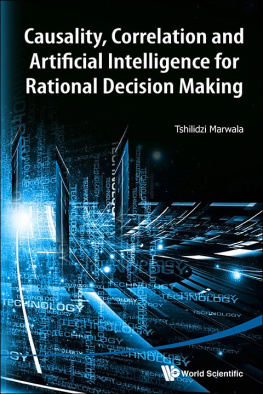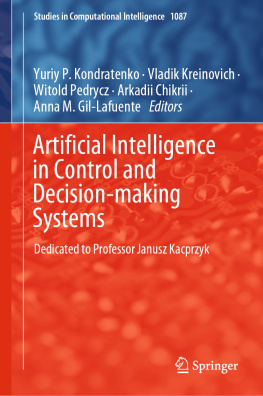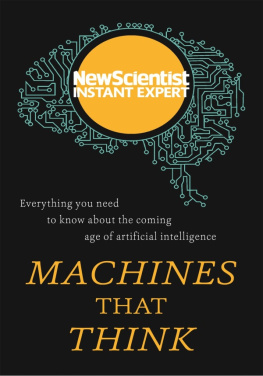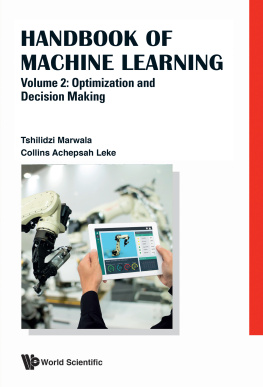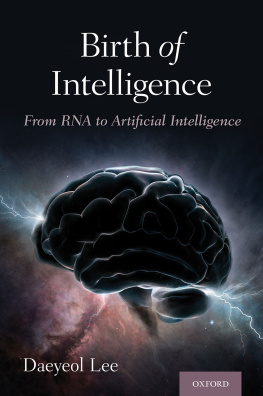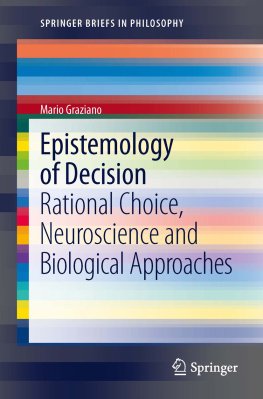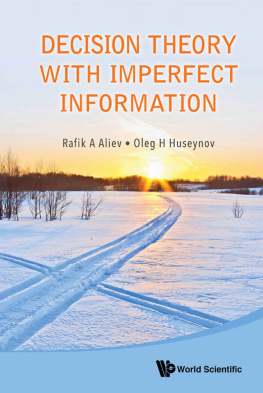Marwala - Causality, Correlation, and Artificial Intelligence for Rational Decision Making
Here you can read online Marwala - Causality, Correlation, and Artificial Intelligence for Rational Decision Making full text of the book (entire story) in english for free. Download pdf and epub, get meaning, cover and reviews about this ebook. City: New Jersey, year: 2015, publisher: World Scientific Publishing Company, genre: Romance novel. Description of the work, (preface) as well as reviews are available. Best literature library LitArk.com created for fans of good reading and offers a wide selection of genres:
Romance novel
Science fiction
Adventure
Detective
Science
History
Home and family
Prose
Art
Politics
Computer
Non-fiction
Religion
Business
Children
Humor
Choose a favorite category and find really read worthwhile books. Enjoy immersion in the world of imagination, feel the emotions of the characters or learn something new for yourself, make an fascinating discovery.
- Book:Causality, Correlation, and Artificial Intelligence for Rational Decision Making
- Author:
- Publisher:World Scientific Publishing Company
- Genre:
- Year:2015
- City:New Jersey
- Rating:5 / 5
- Favourites:Add to favourites
- Your mark:
- 100
- 1
- 2
- 3
- 4
- 5
Causality, Correlation, and Artificial Intelligence for Rational Decision Making: summary, description and annotation
We offer to read an annotation, description, summary or preface (depends on what the author of the book "Causality, Correlation, and Artificial Intelligence for Rational Decision Making" wrote himself). If you haven't found the necessary information about the book — write in the comments, we will try to find it.
Marwala: author's other books
Who wrote Causality, Correlation, and Artificial Intelligence for Rational Decision Making? Find out the surname, the name of the author of the book and a list of all author's works by series.
Causality, Correlation, and Artificial Intelligence for Rational Decision Making — read online for free the complete book (whole text) full work
Below is the text of the book, divided by pages. System saving the place of the last page read, allows you to conveniently read the book "Causality, Correlation, and Artificial Intelligence for Rational Decision Making" online for free, without having to search again every time where you left off. Put a bookmark, and you can go to the page where you finished reading at any time.
Font size:
Interval:
Bookmark:

Causality, Correlation and
Artificial Intelligence for
Rational Decision Making
Causality, Correlation and
Artificial Intelligence for
Rational Decision Making
Tshilidzi Marwala
University of Johannesburg, South Africa

Published by
World Scientific Publishing Co. Pte. Ltd.
5 Toh Tuck Link, Singapore 596224
USA office: 27 Warren Street, Suite 401-402, Hackensack, NJ 07601
UK office: 57 Shelton Street, Covent Garden, London WC2H 9HE
Library of Congress Cataloging-in-Publication Data
Marwala, Tshilidzi, 1971
Causality, correlation, and artificial intelligence for rational decision making / by Tshilidzi Marwala (University of Johannesburg, South Africa).
pages cm
Includes bibliographical references and index.
ISBN 978-9814630863 (alk. paper)
1. Decision making. 2. Artificial intelligence. I. Title.
T57.95.M375 2015
006.301'51--dc23
2014027464
British Library Cataloguing-in-Publication Data
A catalogue record for this book is available from the British Library.
Copyright 2015 by World Scientific Publishing Co. Pte. Ltd.
All rights reserved. This book, or parts thereof, may not be reproduced in any form or by any means, electronic or mechanical, including photocopying, recording or any information storage and retrieval system now known or to be invented, without written permission from the publisher.
For photocopying of material in this volume, please pay a copying fee through the Copyright Clearance Center, Inc., 222 Rosewood Drive, Danvers, MA 01923, USA. In this case permission to photocopy is not required from the publisher.
In-house Editors: Sutha Surenddar/Chelsea Chin
Typeset by Stallion Press
Email:
Printed in Singapore
Preface
Causality, correlation and artificial intelligence for rational decision making covers five significant areas of intellectual inquiry which are causality, correlation, artificial intelligence, rationality, and decision making. It gives new insights on causality and correlations machines and proposes that these form as a fundamental unit for rational decision making.
Causality has been a subject of study for many years and has often been confused with correlation. Human intuition has evolved such that it has learned to identify causality through correlation. This book proposes a model that claims that within any causality model is buried a correlation machine.
This study uses artificial intelligence to build correlation and causality machines. Artificial intelligence methods that are used are the multi-layer perceptron (MLP), radial basis function (RBF), fuzzy inference systems, support vector machines, genetic algorithms (GAs), and simulated annealing (SA). The concepts of causality, correlation and artificial intelligence are then applied in interstate conflict, condition monitoring and several biomedical applications.
This book introduces the concept of flexibly-bounded rationality and uses the correlation and causal machines to implement this. Flexibly-bounded rationality is a special case of bounded rationality.
Furthermore, this book introduces the theory of the marginalization of irrationality for decision making and applies this to the problem of breast cancer diagnosis.
This book is intended for philosophers, computer scientists, engineers, and other interested parties at both undergraduate and graduate levels as well as practitioners.
Acknowledgments
I would like to thank the following institutions for contributing toward the writing of this book: University of Cambridge, University of Pretoria, and University of Johannesburg.
I also would like to thank my students for their assistance in developing this manuscript more particularly Fholisani Mashegana.
I dedicate this book to the schools that gave me the foundation to always seek excellence in everything I do and these are: Mbilwi Secondary School, Case Western Reserve University, University of Pretoria, University of Cambridge (St. Johns College), and Imperial College (London). I thank the Stellenbosch Institute of Advanced Study (STIAS) for the financial support as well as accommodation during the writing of this book.
This book is dedicated to the following people: Nhlonipho Khathutshelo, Lwazi Thendo, Mbali Denga Marwala as well as Dr. Jabulile Vuyiswa Manana.
Professor Tshilidzi Marwala, Ph.D.
Johannesburg
1 February 2014
Contents
Abstract.In this chapter, decision making which is based on causality, correlation and artificial intelligence is introduced. The concept of correlation is introduced and is applied to build a correlation function. Furthermore, it relates causality to correlation and uses it to build a causal function. Artificial intelligence methods are introduced and these include neural networks, particle swarm optimization, genetic algorithm and simulated annealing. It describes decision making and outlines the rest of the book.
The problem of understanding causality has pre-occupied philosophers for a very long time. From the times of Plato and Aristotle and even before that period, mankind has been asking why and how they are on this planet and various answers to these questions involve causality. The very idea that a higher being, or a great architect of the universe created, mankind is squarely premised on the principle of causality. The significance of understanding causality to satisfy human curiosity and enhance the functioning of society is enormous. As an example, the medical field is based on the premise that some medicines cause healing of diseases. To link specific medicines to the curing of diseases requires a good understanding of causality and as long as this understanding is not complete the results of clinical studies will always be sub-optimal. One example to illustrate this, is the avocado pear that was thought to be dangerous because the causal relation between avocado pear consumption and cholesterol was poorly understood but today it is considered good for ones cholesterol.
There is an old Tshivenda saying that states: Tsho bebiwaho tsho fa (Marwala, 2013a). What this expression signifies is that there is a perfect correlation between birth and death and those who are born will necessarily die. Many have simplified and misinterpreted this allegory to purport that it alludes to the fact that birth causes death. In fact, there is an information flow from birth to death but this is not causal information. It might be that the actual causal relation for this case was between a road accident and death, therefore, the road accident caused death. This example illustrates a very simple explanation of what a cause is and what a correlation is. On trying to understand causality, it is vital to understand the principle of correlation because within any causal model lies a correlation function.
In this section, we explore the concept of correlation, what it is and what it can be used for. To illustrate this, we invoke the relationship between obesity and heart attack. In this example, the two variables x indicating a persons weight and y indicating whether they had a heart attack. In this case, variable x is positively correlated to variable
Font size:
Interval:
Bookmark:
Similar books «Causality, Correlation, and Artificial Intelligence for Rational Decision Making»
Look at similar books to Causality, Correlation, and Artificial Intelligence for Rational Decision Making. We have selected literature similar in name and meaning in the hope of providing readers with more options to find new, interesting, not yet read works.
Discussion, reviews of the book Causality, Correlation, and Artificial Intelligence for Rational Decision Making and just readers' own opinions. Leave your comments, write what you think about the work, its meaning or the main characters. Specify what exactly you liked and what you didn't like, and why you think so.

